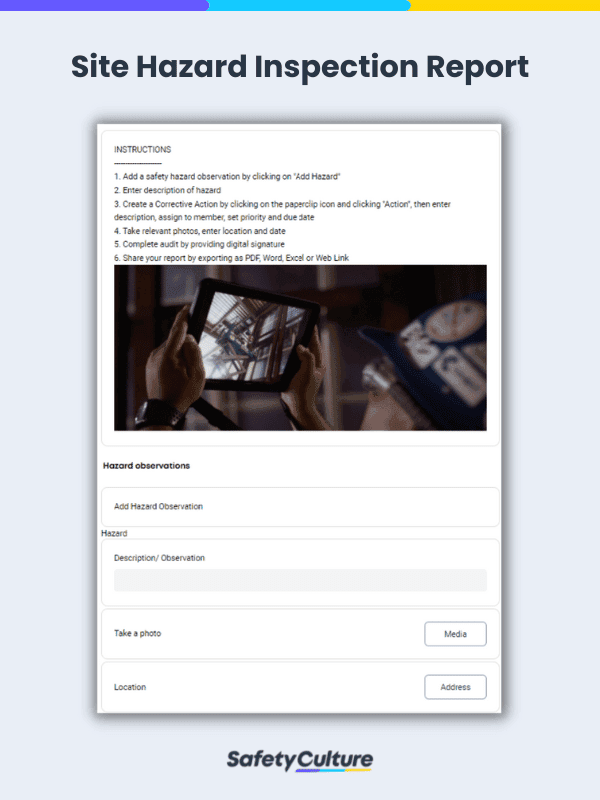What are Site Inspection Reports?
Site inspection reports are valuable tools used to document findings from a visual inspection done in the worksite. These reports summarize risks and hazards identified and preventive controls in place. Creating good site inspection reports help safety officers and managers compile all needed data for safety planning and overall success of the project.
While just about any type of work environment can benefit from a good site inspection report, it most commonly associated with construction work. According to OSHA, one in five worker deaths annually is in construction; a testament to just how dangerous construction work can be. In a field where fatalities and serious injuries occur so frequently, safety cannot be taken for granted.
Here is a inspection report format of a ready-to-use site inspection report template.
Why are they Important?
Site inspection reports serve several purposes for an organization. They help prevent accidents by identifying potential hazards on job sites and enabling safety officers to address them immediately. Site inspection reports also document progress and improvement, which can be helpful for billing purposes and for keeping track of project milestones. In some cases, they may even be required by law such as when working on a government project.
Regardless of the purpose, site inspection reports are an important tool for any business or individual conducting work on a job site. By taking the time to document conditions and identify potential hazards, they can keep everyone safe and avoid costly accidents that can cause operational disruptions.
How to Write an Inspection Report?
A good site inspection report is composed of multiple elements that work well together. Though the contents of each report may vary depending on factors such as team size, nature of work, and available resources, the elements discussed below are relevant to all use cases of site inspection reports:
It consistently adheres to set standards
Across your entire organization, your standards for what a good site inspection report looks like must be consistent. One of the main challenges, especially with larger corporations that operate in several locations, is keeping every personnel aligned with quality standards. A good site inspection report must be consistent with the company’s set standards so collaboration across different teams, departments, and sites to address identified issues are streamlined.
It caters to the right audience
Is the site inspection report for internal use? Is it meant to be accessed and reviewed only by employees of the company?; or is it a site inspection report specifically requested by a client? A good site inspection report must know its target audience. Through knowing, site inspection reporters can adjust the language and terminology so the information can be communicated clearly no matter who is on the receiving end.
It is founded on accountability
Establishing a culture of accountability is one of the most important factors in consistently producing good site inspection reports. In essence, the first two items can only be achieved across the entire organization if a culture of accountability has been established beforehand. Accountability within the organization ensures that each and every person is aware of the importance of their role which compels them to do their best to fulfill them.
What is a Site Inspection and its Scope?
A site inspection is the process of regularly assessing the specific location of ongoing projects, and the activities involved in them while ensuring that they are executed safely. In the construction industry, inspections are critical in every aspect of the construction project. Site inspections are usually done once per week and within 24 hours of significant rain.
These inspections are done to be compliant and guarantee that activities involved in the construction project are done as planned and according to requirements. Contractors also use inspections to ensure that they don’t destroy the site and soil during the project; otherwise, profits are lost.
Conducting site inspections requires field inspectors to inspect the following:
- Areas disturbed by construction activity
- Areas used for storage of materials exposed to precipitation
- Areas where control measures are installed and maintained
- Areas where pollutants have accumulated and may enter stormwater
- Locations where vehicles enter or exit the site
- Areas where stormwater typically flows
- Points of discharge from the site
- Portions of the site where stabilization measures have been initiated
As inspectors check these areas, there are certain things to look out for. Among these are the following:
- Check for the presence of accumulated sediment near the project area boundary that has a potential for being washed outside of the project boundary on locations such as roadways or parking lots, stormwater conveyance systems, storm drain inlets, and discharge points
- Check for evidence of, or potential for, spills, leaks, or other accumulations of pollutants on the site entering the stormwater conveyance system or water bodies
- Check visible areas where erosion has occurred near the project area boundary that has a potential for being washed outside of the project boundary
- Check locations where new or modified measures are necessary
- Check all points that discharge from the site and determine the conditions contributing to that discharge
- Take note of incidents of noncompliance observed and corrective actions taken (if any)
Once the site inspection is complete, it is required to prepare a report containing all the information collected. A good site inspection report should contain a detailed description of any identified issues and the appropriate corrective actions to be taken. Inspection reports should also contain signatures of authorized and appropriate persons.
What is a Site Inspection Report Template?
A site inspection report template is a ready-to-use document that empowers organizations to efficiently conduct site inspections as often as necessary. These templates usually enumerate the items that need reviewing, allow people in charge to create immediate corrective actions for hazards and errors found, and generate comprehensive reports that give stakeholders an overview of the project.
What to Include?
A site inspection report template is constructed with a specific project in mind. Its inclusions, however, can range from, but are not limited to the following items:
- Site name
- Location
- Date of inspection
- Name of inspector and signature
- Instructions
- Hazards/other observations
- Additional comments
How to Use a Site Inspection Report Template?
There are a few things that you should keep in mind when you are using a site inspection report template. First, you need to make sure that you are using the correct template for the type of inspection that you are conducting. There are a variety of available templates, so you need to make sure that you are using the right one.
Second, you need to make sure that you are familiar with the format of the template. This will help you to properly fill out the report and to make sure that all of the information is accurate. Third, you need to make sure that you include all of the relevant information in the report. This includes pictures, descriptions, and any other pertinent information.
Fourth, you need to make sure that you are using the correct terminology in the report. This is important so you do not confuse the reader or the people reviewing the report. Fifth, you need to make sure that you are proofreading the report before you submit it. This will help to ensure that there are no errors or inaccuracies in the report.


